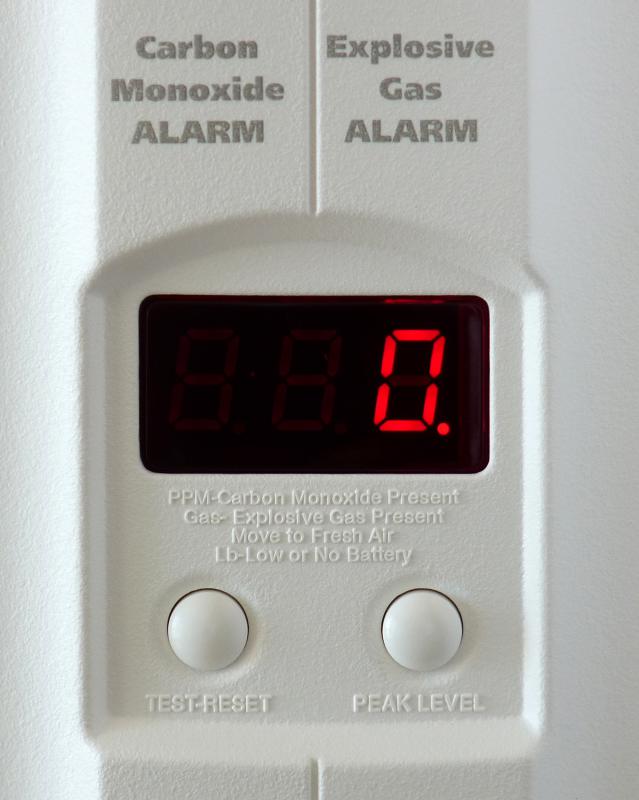At WiseGEEK, we're committed to delivering accurate, trustworthy information. Our expert-authored content is rigorously fact-checked and sourced from credible authorities. Discover how we uphold the highest standards in providing you with reliable knowledge.
How do I Choose the Best Carbon Monoxide Detector?
Installing a carbon monoxide detector, or even multiple detectors, in a home can be a lifesaving move. Some U.S. states require that all dwellings be equipped with a monitor, which detects the presence of carbon monoxide in the air. In most states, there is no requirement for installing a carbon monoxide monitor, and it is up to a home owner or renter to install this safety device. To choose the best device, decide whether you want one that is combined with a smoke detector, if you want a battery or plug-in version, if you would prefer an analog or digital model, and if you want one that ties into your security system.
Carbon monoxide (also known by its chemical name, CO) is an odorless, colorless, and tasteless gas that is produced by operating such things as fireplaces, wood stoves, gas appliances, and running vehicle engines. Using these appliances or equipment in or near a home creates the need for the use of a detector in order to prevent carbon monoxide poisoning. Poisoning can be caused by gas leaks and fumes that are produced, yet impossible to detect until a person becomes ill, or in extreme cases, death occurs due to lack of oxygen in the blood.

Carbon monoxide detectors work in a way that is similar to smoke detectors, where an alarm sounds to warn people of danger. The two devices warn of completely different dangers, however. There are a variety of combination detectors available on the market for the person who wants both dangers monitored in one device.
Another type of carbon monoxide detector is a simple device that sounds an alarm or series of beeps to indicate that CO is present in high concentration. This type of detector is good for use in a house that is already equipped with smoke detectors. These devices are available as a unit that plugs in to a wall power source, as one that requires the use of batteries, or a combination of both. Consider where the CO detector will be placed and if a power source will be available at all times. Should you run gas appliances or heat a home with a wood stove, for example, it might be best to buy one that has battery back up in case your home loses power during a power outage.

Some detectors have front loading battery compartments, which is a convenient feature for some users. This makes it easier to replace batteries as needed without having to worry about re-mounting the monitor correctly. Front loading monitors can also be very practical when a device is installed in a difficult to reach area.
If carbon monoxide leaks have been a problem in the past, or if a person is very concerned about the actual level in parts per million of CO in the air, a digital model is available. These models will monitor and display a precise reading of how much carbon monoxide has been, or is in, the air. They are generally available as a plug-in model with a battery back-up.

For those people who have a home security system, or are considering installing one, a carbon monoxide detector can be connected to the system. By connecting the detector, a monitoring station will be able to notify the security system owner about carbon monoxide dangers within the home, just as fire and intrusions are monitored. People who choose this method of CO monitoring should have the device installed by a professional to ensure that the monitor is set up correctly.

There are many choices and options to consider when choosing a carbon monoxide detector; however, one aspect of this decision that should not be overlooked is that the product should be UL Listed. UL listing is often required for the product to be approved by an insurance company, though it does not guarantee that the product will actually work. Check with your homeowner's or renter's insurance company to find out about any electrical safety requirements that may be listed.
AS FEATURED ON:
AS FEATURED ON:















Discussion Comments
@hyrax53-- Our detector is really good about that because it sets off an alarm when the battery is low. So it leaves no choice but to change the battery.
We have a kind of old carbon monoxide detector at home that doesn't beep, it only flashes a red light when it senses carbon monoxide. It's not good because the other day, someone left the stove on and we didn't notice the flashing light until twenty minutes later.
We need to change our detector and get one that makes noise.
In my experience many carbon monoxide detector alarms are similar in sensitivity. The biggest problem, as with smoke detectors, is that the batteries will die and then not be replaced. As long as you remember to keep the batteries in the detectors juiced, most should be fine for basic home use.
Post your comments